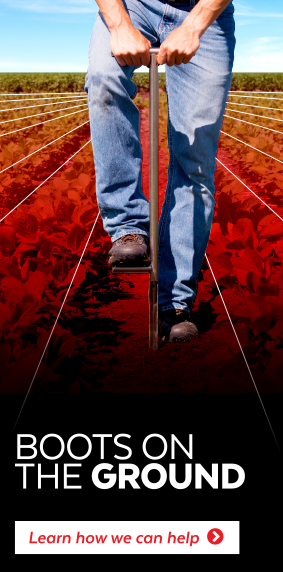When field and weather conditions are just right, it can be very tempting to load up the planter with seed, get in the tractor, and plant straight through the acres. However, setting aside a few minutes to take some field notes can save you both time and money for current and future growing seasons. Planter performance and weed identification are among the key areas that growers should pay particular attention to, and that is what the E4 Crop Intelligence experts are going to cover in this article.
Inspecting The Planter
Even though your planter might’ve been inspected and calibrated, you should occasionally hop out of the cab and evaluate your seed placement and check to see if the planter disk openers and closing wheels are functioning correctly. It is also essential to do this when you notice or know sections of your field have changing soil conditions.
Seed Placement
Making sure your seed is being placed and closed at the proper depth, within the moisture zone, is vital to having ideal germination and strong emergence. Thoroughly inspect this by digging behind a test section of each of the rows you have started to plant. See where the seed is being placed. While it may seem time-consuming, it allows you to gauge seed uniformity and if it’s hitting the target depth. Having uneven seed placement that is too shallow or too deep will lead to areas of inconsistent emergence or non-emergent seed.
Disc Openers, Row Cleaners, and Closing Wheels
Spot checks are also recommended for your planter’s disc openers, row cleaners (if you are using them), and closing wheels to verify that each component is doing its job in placing the seed for uniform emergence.
Disc openers that have the right contact points in the front should be able to cut through the soil and create a furrow. Openers that are not set right tend to ride up out of the ground, which leads to inconsistent furrow depth.
For row cleaners, the units should be removing debris and residue from the seed trench. An ideal setting for row cleaners is where they ride on top of the soil, only penetrating just below the soil surface to pick up debris. If they go too deep into the seedbed, causing the soil to be pushed to the outside of the row, it can create an uneven planting depth.
Closing wheels should be moving enough soil to close the seed trench without any air pockets around the seed. Too much downward pressure from the closing wheel will push the seed into the earth in a way that limits root growth. Check the test rows to make sure that the soil over the seed is soft enough for successful emergence.
Weed Check
When you’re out in the field, take the time to note and identify any weeds you may see while planting. Scouting for weeds can help you get a plan together on how to manage them before they get out of control. Weeds that might emerge in mid-April are Kochia, giant ragweed, and common ragweed. More significant and noxious weeds, like redroot pigweed, Palmer amaranth, and waterhemp, have been observed emerging as early as May.
Palmer amaranth is a very aggressive weed that has become a significant threat to fields throughout the U.S., as it has evolved resistance to ALS-inhibitor- and glyphosate-based herbicides. One way to identify a young Palmer amaranth seedling is by looking at its leaves and stem. The leaves will have extended petite (stalk that attaches to the leaf blade) on early, often being longer than the leaf itself. Palmer amaranth is a type of pigweed. While many pigweed species have spiny stems, Palmer amaranth has a smooth stem.
Taking these types of notes while you are out in the field this spring should help your operation in the long run. To capture more success this planting season and beyond, find out more about E4 Crop Intelligence services by contacting us.
